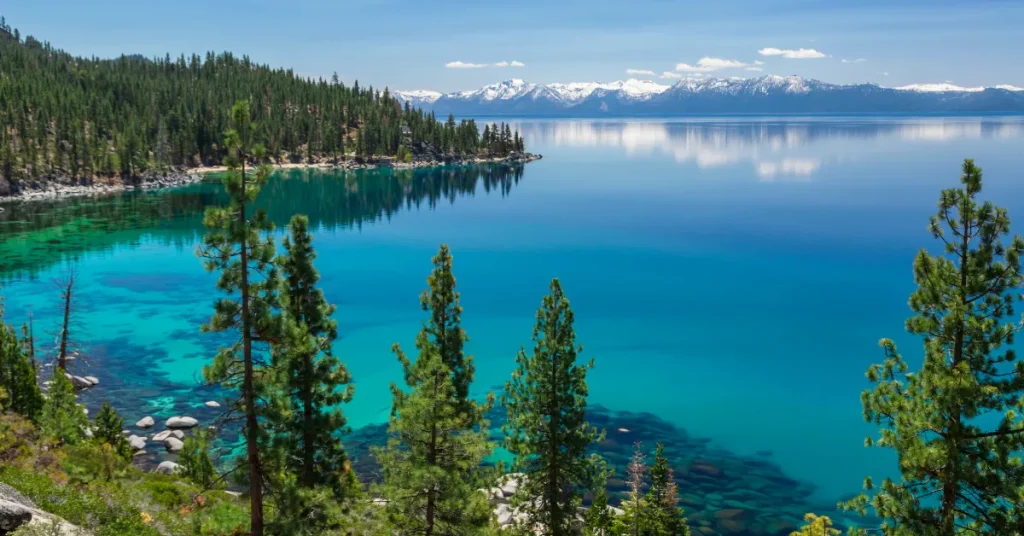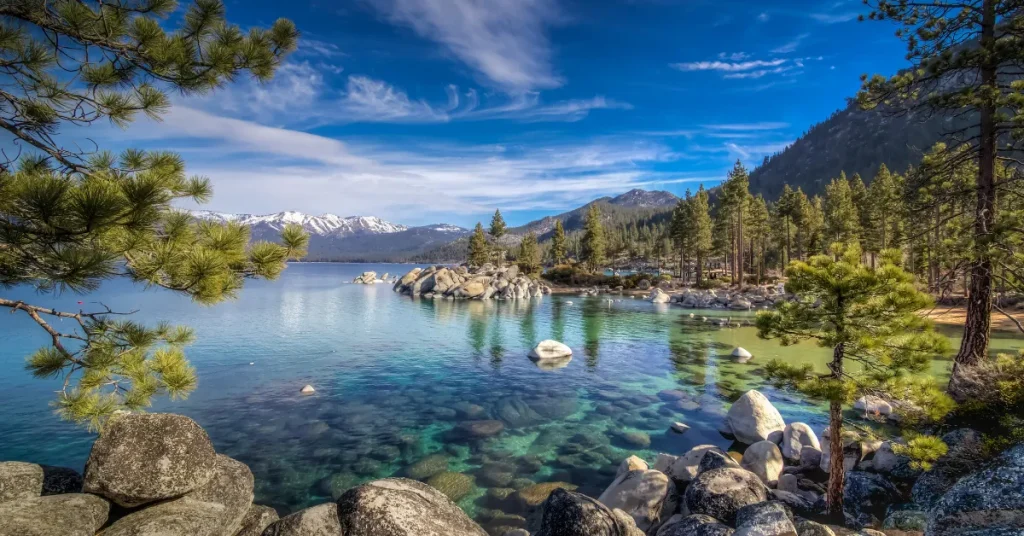Lake Tahoe spans 12 miles in width. Its width is complemented by a length of 22 miles.
Nestled in the Sierra Nevada mountains, Lake Tahoe draws visitors with its stunning clarity and majestic surrounding landscapes. As one of the largest alpine lakes in North America, it sits at an elevation of over 6,000 feet.
This freshwater gem borders both California and Nevada, offering a plethora of recreational activities year-round.
With crystalline waters that have captivated both tourists and locals, Lake Tahoe boasts not just natural beauty but also a rich historical tapestry.
The lake’s vastness invites adventurers to explore its depths, while the scenic vistas provide a serene backdrop ideal for relaxation and photography.
Renowned for its clear blue waters, Lake Tahoe remains a jewel of the American West and a must-visit destination for nature enthusiasts.

Introduction To Lake Tahoe’s Grandeur
Embraced by majestic mountains, Lake Tahoe is a spectacle of nature’s beauty. This alpine lake, one of the largest, draws visitors with its crystal-clear waters and stunning surroundings.
Let’s delve into Lake Tahoe’s enchanting dimensions and its significance in the realm of natural wonders.
Lake Tahoe’s Place In Natural Wonder
Lake Tahoe is not just a lake; it’s a masterpiece. With vibrant blue waters and snow-capped peaks, it stands as a landmark of pure wilderness. Here’s a quick snapshot of its impressive stats:
- Depth: It plunges to over 1,600 feet, making it the second deepest lake in the USA.
- Elevation: Rests at over 6,000 feet above sea level, adding to its mystique.
- Age: It has been a natural basin for over 2 million years.
Why Its Size Matters
The scale of Lake Tahoe is crucial. It’s not just about numbers; it’s about the impact. Tourists and environmentalists marvel at its sheer volume. With a width of about 12 miles, Lake Tahoe has room for both recreation and habitat.
| Measurement | Value |
| Surface Area | 191 square miles |
| Shoreline | Approx. 72 miles |
| Width | Up to 12 miles at its widest |
It supports a diverse ecosystem and offers endless adventure. From kayaking to fishing, its size allows everyone to experience its grandeur. This massive body of water is both a playground and a sanctuary.
Delving Into Dimensions

Set against a backdrop of breathtaking scenery, understanding the size of Lake Tahoe adds to the appreciation of its grandeur. Delving into Dimensions
Measuring Lake Tahoe’s Width
Revered for its stunning clarity and depth, Lake Tahoe’s width is equally impressive. Spanning 12 miles (19 kilometers) wide, its expanse is measured at its widest points, from the West Shore to the East Shore.
| Measurement Point | Width |
| West Shore to East Shore | 12 miles (19 kilometers) |
Comparing To Other Notable Lakes
To put things in perspective, Lake Tahoe stands out among other famous lakes. It is wider than Crater Lake, yet smaller in width than Lake Michigan.
- Lake Tahoe: 12 miles wide
- Crater Lake: Approximately 6 miles wide
- Lake Michigan: Up to 118 miles wide
This comparison showcases Lake Tahoe’s unique size among natural freshwater marvels.
Historical Perspectives On Size
Lake Tahoe, nestled in the Sierra Nevada mountains, has long captivated humans with its size.
Generations have marveled at its vastness, capturing the imagination and influencing stories passed down through the years. Let’s delve into Lake Tahoe’s historical dimensions and their cultural significance.
Early Measurement Attempts
The quest to quantify Lake Tahoe’s width began with early Native American inhabitants. They estimated distances by canoe travel time.
By the mid-19th century, European explorers took interest. They used rudimentary tools to make more precise calculations.
- Ancient methods included visual estimation.
- Tools evolved from ropes to telescopes and maps.
Impact On Local Cultures And Lore
Lake Tahoe’s massive size has deeply influenced nearby communities. Its enormity is reflected in local myths and legends, often attributing mystical qualities to its waters.
Historical estimates of size were not just numbers, but also narratives that bound societies together.
| Culture | Belief or Lore |
| Native American | Lake as a sacred place with healing powers. |
| Early Settlers | Stories of giant creatures dwelling in its depths. |
Stories and celebrations often echo the lake’s grandeur, ensuring its size remains a cornerstone of regional identity.
Technological Advancements In Lake Metrics
Exploring the vast expanse of Lake Tahoe has always been fascinating. With the area’s sheer size, individuals often wonder, how wide is Lake Tahoe? Today, cutting-edge technology gives us precise answers.
Technological advancements in lake metrics have revolutionized our understanding of bodies of water like Lake Tahoe.
Modern Methods For Defining Lake Sizes
Now, scientists use innovative tools to measure lakes. Gone are the days of rough estimates. We now have techniques that define lake sizes with amazing accuracy.
Devices that measure depth, GPS mapping, and digital modeling are key. These tools work together to paint an accurate picture of lakes.
- Bathymetry – uses sound waves to map lake floors.
- GPS mapping tools – they capture lake dimensions precisely.
- 3D modeling software – provides detailed visuals of lake contours.
Such tools allow for meticulous lake measurements. They ensure data on the width and volume of lakes like Tahoe is spot-on.
Satellites And Sensors: A New View Of Tahoe
Satellite imagery offers crystal-clear views of large lakes. Researchers use it to assess the Lake Tahoe area from above. Satellites snap shots of the lake, showing its true width and changes over time.
Sensors placed in and around the lake track water quality and levels. They gather vital data, feeding it to scientists for analysis. The sensors reveal subtle shifts in the lake’s size and health.
| Type of Technology | Function |
| Satellites | Capture images to determine lake width |
| Sensors | Monitor changes in water conditions |
Together, satellites and sensors provide an unparalleled view of Lake Tahoe. This fusion of technology maps the lake accurately, ensuring no detail escapes scrutiny.
Visitors’ Experiences & Perceptions
Lake Tahoe stretches far and wide, captivating visitors with its immense beauty.
Its vastness surprises many who see it for the first time.
Every year, it draws a crowd eager to witness its expanse and share their stories.
Personal Accounts Of Lake Tahoe’s Breadth
Travelers often share their experiences of Lake Tahoe’s size.
Many can’t believe how large it is until they see it.
Some visitors have shared:
- “I thought I could see the other side, but it was much bigger.”
- “Pictures don’t show how wide Lake Tahoe really is.”
- “It took much longer to drive around than we expected!”
Each story reveals the lake’s unexpected scale.
Photography And The Illusion Of Size
Photos often don’t capture Lake Tahoe’s true width.
The lake spans 22 miles at its widest, and cameras can deceive.
Amateur photographers note:
- “My lens couldn’t capture the whole width!”
- “From a photo, you can’t grasp the scale.”
Visitors are encouraged to see the lake themselves for the full effect.
Environmental Factors Affecting Lake Size

The size of Lake Tahoe, one of the largest freshwater lakes in the U.S., can be influenced by various environmental factors.
Understanding these interactions is key to preserving its grandeur. Two major elements to consider are climate patterns and human efforts in conservation.
Climate Change And Water Levels
Climate change directly impacts Lake Tahoe’s water levels.
- Warming trends lead to altered precipitation patterns.
- Snowfall becomes rain, causing earlier runoffs into the lake.
- Evaporation rates increase during hotter, drier summers.
Rising temperatures and fluctuating precipitation thus shape the lake’s size over time.
Human Intervention: Preserving The Majestic Size
To maintain the size and health of Lake Tahoe, human intervention plays a crucial role.
- Regulations limit the usage and development around the lake.
- Conservation initiatives restore natural habitats and improve water quality.
- Community efforts reduce pollution to prevent the lake from shrinking.
Jointly, these actions help safeguard the lake’s pristine dimensions for future generations.
FAQs About How Wide Is Lake Tahoe
Is Lake Tahoe The Biggest Lake In The World?
No, Lake Tahoe is not the biggest lake in the world. It ranks as the 26th largest by volume and the second deepest in the United States.
How Deep Is The Deepest Part Of Lake Tahoe?
The deepest part of Lake Tahoe is 1,645 feet. This impressive depth makes it one of the deepest lakes in the United States.
Why Is Lake Tahoe So Big?
Lake Tahoe’s size results from its geological history, with glacial carving and tectonic movements creating this vast, deep basin, filling it with water over millennia. Its large surface area reflects a significant catchment area and substantial rainfall and snowmelt contributions.
Is Lake Tahoe Man Made?
Lake Tahoe is not man-made; it is a natural freshwater lake situated in the Sierra Nevada mountains.
Conclusion
Revel in the wonders of Lake Tahoe’s impressive width, a testament to its glacial origins. Spanning 12 miles at its widest point, the lake offers vast panoramas and boundless adventure.
Remember, this alpine beauty’s vastness is matched only by the memories it promises to create.
Discover, explore and cherish Lake Tahoe’s grand scale.
Resources:
1. https://travelnevada.com/destinations/lake-tahoe/
